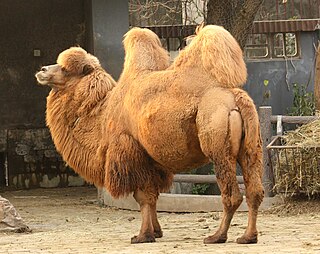
A camel is an even-toed ungulate in the genus Camelus that bears distinctive fatty deposits known as "humps" on its back. Camels have long been domesticated and, as livestock, they provide food and textiles. Camels are working animals especially suited to their desert habitat and are a vital means of transport for passengers and cargo. There are three surviving species of camel. The one-humped dromedary makes up 94% of the world's camel population, and the two-humped Bactrian camel makes up 6%. The wild Bactrian camel is a distinct species that is not ancestral to the domestic Bactrian camel, and is now critically endangered, with fewer than 1,000 individuals.

Camelids are members of the biological family Camelidae, the only currently living family in the suborder Tylopoda. The seven extant members of this group are: dromedary camels, Bactrian camels, wild Bactrian camels, llamas, alpacas, vicuñas, and guanacos. Camelids are even-toed ungulates classified in the order Artiodactyla, along with species including whales, pigs, deer, cattle, and antelopes.

The dromedary, also known as the dromedary camel, Arabian camel, or one-humped camel, is a large camel, of the genus Camelus, with one hump on its back.

The Bactrian camel, also known as the Mongolian camel, domestic Bactrian camel or two-humped camel, is a large camel native to the steppes of Central Asia. It has two humps on its back, in contrast to the single-humped dromedary. Its population of 2 million exists mainly in the domesticated form. Their name comes from the ancient historical region of Bactria.

Ceratotherium is a genus of the family Rhinocerotidae, consisting of a single extant species, the white rhinoceros, as well as several fossil species.

Neurotrichus is a genus of shrew-like moles. It is classified, together with the fossil genus Quyania, in the tribe Neurotrichini of the subfamily Talpinae. The only living species is the American shrew-mole (N. gibbsii) of the northwestern United States and British Columbia. A fossil species, Neurotrichus columbianus from the Hemphillian of Oregon, was placed in the genus in 1968, but this animal is now thought to be more closely related to the Chinese fossil genus Yanshuella.

Camelops is an extinct genus of camel that lived in North and Central America, ranging from Alaska to Honduras, from the middle Pliocene to the end of the Pleistocene. It is more closely related to living camels than to lamines, making it a true camel of the Camelini tribe. Its name is derived from the Ancient Greek κάμηλος and ὄψ, i.e. "camel-face".
Numidotheriidae is an extinct family of primitive proboscideans that lived from the late Paleocene to the early Oligocene periods of North Africa.

Urotrichus is a genus of talpid that contains a single living species, the Japanese shrew mole (Urotrichus talpoides). Two fossil species are also known.

Dyrosaurus is a genus of extinct crocodylomorph that lived during the early Eocene. The name Dyrosaurus comes from sauros (σαῦρος) the Greek for lizard or reptile, and Dyr for Djebel Dyr (mountain) close to where the type species was discovered. It was a large reptile with an estimated body length of 6.5 metres (21 ft).
Paracamelus is an extinct genus of camel in the family Camelidae. It originated in North America Around 8-7 Ma, and crossed the Beringian land bridge into Eurasia during the Late Miocene, about 6 million years ago (Ma). It is the presumed ancestor to living camels of the genus Camelus.

The hybrid camel is a domestic camelid hybrid between a Bactrian camel and dromedary. It is the offspring of a male Bactrian camel and a female dromedary.

The wild Bactrian camel is an endangered species of camel endemic to Northwest China and southwestern Mongolia. It is closely related but not ancestral to the domestic Bactrian camel. Genetic studies have established it as a separate species which diverged from the Bactrian camel about 0.7–1.1 million years ago.
Jerzy Dzik is a Polish paleontologist.
Tapirus mesopotamicus is an extinct species of tapir that lived in South America during the Pleistocene. It is considered a possible ancestor of all extant South American tapirs.

Palaeomephitis steinheimensis is an extinct species of musteloid, possibly a mephitid (skunk), from the Miocene epoch of Europe.
Camelus knoblochi is an extinct species of camel from the Pleistocene. One of the largest known camel species, its range spanned from Eastern Europe to Northern China.
Gazella atlantica, the Atlantic gazelle, is an extinct species of gazelle that lived in Northwest Africa during the Late Pleistocene.
Lynx thomasi is an extinct fossil species of lynx. It was described in 1980 based on a lower jaw fossil found in Pleistocene-aged rock in Morocco.











